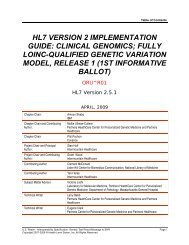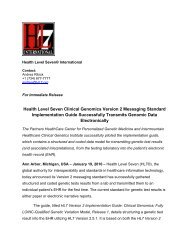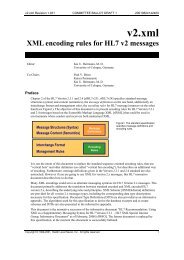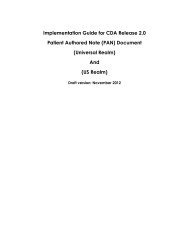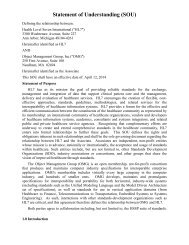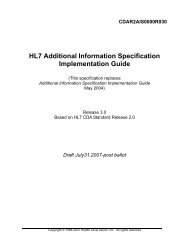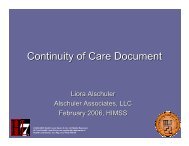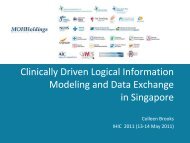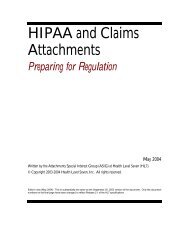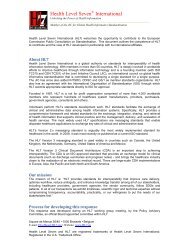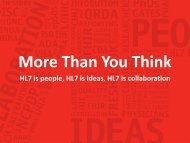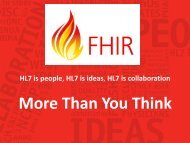Templates and Archetypes GF.fm - HL7
Templates and Archetypes GF.fm - HL7
Templates and Archetypes GF.fm - HL7
Create successful ePaper yourself
Turn your PDF publications into a flip-book with our unique Google optimized e-Paper software.
RMIM classes <strong>and</strong> CMETs. The term archetype is used to describe concepts that arerecorded in the EHR which can be usefully linked to an ontology.Table 1: Naming considerationsNameDescriptionCurrentopenEHRCurrentCDACurrent<strong>HL7</strong>messagesPrimaryarchetypeOrganisationalarchetypes<strong>Templates</strong>Discrete whole conceptsrecorded in EHRRepresent concepts usedto organise EHR <strong>and</strong>may constrain the containedprimary archetypesConstraint specificationsexpressed in termsof organisational archetypes<strong>and</strong> primary archetypesEntryarchetypesOrganiserarchetypesEntry templates<strong>and</strong> RMIMclasses <strong>and</strong>CMETsSectiontemplates<strong>Templates</strong> ? ?RMIMclasses <strong>and</strong>CMETs?During detailed discussion, the terms templates, organisational archetypes <strong>and</strong> primaryarchetypes should be used. The <strong>HL7</strong> <strong>and</strong> openEHR communities would need to agreethat:• The semantics of the <strong>HL7</strong> may reside partly in the RIM, partly in the RMIM(<strong>and</strong> CMETs) <strong>and</strong> partly in the primary archetypes. Matching the semanticswith the openEHR archetype may prove difficult in the message world - butshould be easier in the somewhat aligned CDA world.• The semantics of the openEHR archetypes reside in the archetype alone -which is linked to an ontology.• The need to register primary <strong>and</strong> organisational archetypes is absolute - howmany are required for use with the CDA is not clear as the power of the semanticsexpressed in the current version 2 RMIM has not been tested. openEHR islikely to require a few hundred to achieve reasonable interoperability.• The primary archetypes are at the level of the ‘ENTRIES’ in the CDA RMIM<strong>and</strong> the openEHR reference model - providing an opportunity for covergentwork.For the <strong>HL7</strong> community, organisational archetypes will apply to CDA SECTIONS, <strong>and</strong>some messages. Primary archetypes will apply to CDA ENTRIES where the model isrequired for semantic interoperability <strong>and</strong> the full semantic is not provided by theRMIM. In openEHR, ‘organisational’ archetypes will apply to ORGANISERS <strong>and</strong> ‘primary’archetypes will apply to openEHR ENTRIES.The ‘templates’ with the weakest links to the knowledge base <strong>and</strong> the strongest link toquality <strong>and</strong> practice - will apply to predominantly to <strong>HL7</strong> CDA documents, openEHR



